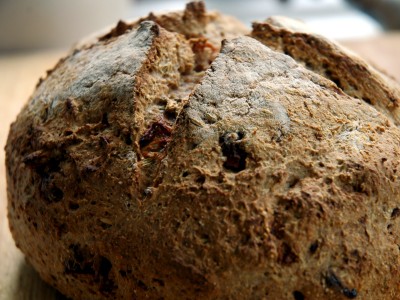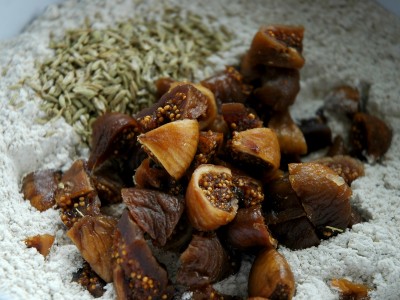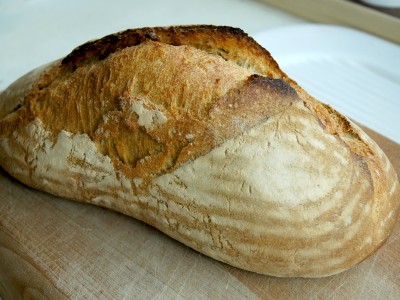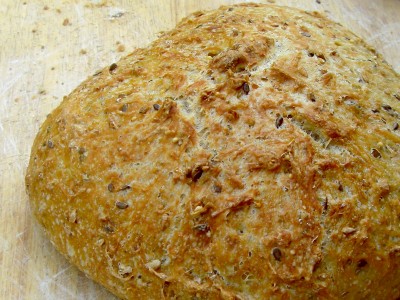Fig and fennel seed soda bread recipe
A few weeks ago, I wanted a sweet treat but didn’t have enough butter in the house to make something cake-ish. After a bit of Googling around for inspiration, I came up with this sweet bread instead – and because it doesn’t use yeast and doesn’t need kneading, it’s ready to eat in next to no time.
It’s a little different to my usual soda bread – I’ve made it a few times now to tweak the flavourings but my expert focus groups contradicted each other with their opinions on less or more fennel seeds (same loaf, wildly different opinions), so I’ve made it how I like it, sod them ;) If you like the liquorice taste of fennel seeds, you might want to up it to 5tsp of seeds; if you prefer it to be subtler (but still there in the background), drop it down to 3tsp. And don’t feed it to any of my contrary friends ;)
It can be baked on a flat cookie sheet (dusted with flour or semolina) or in a lidded cast iron casserole dish (like the slow rise bread). The latter traps moisture and reduces the cooking time – but make sure it’s super hot before adding the dough or it’ll stick.
Fig and fennel seed soda bread recipe
Ingredients:
To make soured/acidified milk
300ml of milk
1tbsp of lemon juice
For the bread
450g/1lb of flour: about 200g plain white flour and 250g of rye flour
1tsp of caster sugar
1/2 tsp of salt
2tsp of bicarbonate of soda
2tsp of cream of tartar
4tsp of fennel seeds
175g (ish) of dried figs
A little extra flour/semolina for dusting
Real Bread week: our favourite bread recipes
Apparently it’s Real Bread Maker week this week. I’m not sure why it’s not just Real Bread week, why it has to be all about breadmakers but either way, mmm bread.
When I left my last-but-one job I was given a juicer as a leaving present. As I hate juice, I swapped it for a bread maker. We probably made bread in it about a dozen times — admittedly a dozen more times than we would have used the juicer — but not enough to warrant it taking up a whole lot of space in our then-tiny kitchen. We just weren’t impressed with the bread from it – we tried a number of different recipes but none were impressive enough to be worth the effort. A few years ago, we gave the gadget to John’s sister and worked out how to make much better bread without it.
Aside from meal-centric breads like chapattis, naans and pizza dough, we tend to make three types of bread: yeast-based slow rise no knead bread, sourdough and soda bread.
Sourdough
The sourdough is by far the most labour intensive because in addition to the regular bread making stuff, we have to keep our starter alive all the time even though we don’t bake it that often. When we do make it, we use the Handmade Bakery’s “Yorkshire Leaven” and their pain de campagne recipes – the former uses a sourdough “production starter” which is left overnight before the bulk of the flour added, whereas the latter is fully mixed & kneaded then left overnight. The two different options mean we can pick the recipe which suits our schedule better – whether we have more time right then or will have more time the following day. Both result in a really tasty, substantial loaf – not like fluffy barely-there white bread from the supermarket but a real part of a meal.
Pros:
- Really, really tasty bread
- Minimal ingredients – just water, flour, a little salt & starter (which is flour & water with natural yeasts)
- Breads in theory last up to a week. Usually eaten well before that here!
Cons:
- A chore to keep the starter alive if not baked regularly
- Needs to be in a warm place during rise/proving times
- Needs to be started well in advance of eating
Slow rise no knead bread
In comparison to the sourdough, slow rise no knead bread is less flavourful – that’s not to say it’s not tasty in its own right, just it’s not so zingy. The texture is similar though – substantial with large air bubbles; you know you’re eating it, that’s for sure. It needs leaving overnight like the sourdough too but the actual involved-making time is minimal – time does the hard work so you don’t have to ;) It takes less than five minutes to mix the dough then it’s left for 12 hours or so, shaped (which takes no more than a minute), left to prove for a couple of hours then baked. And it uses only store cupboard ingredients – no pesky, needy starters. I’m willing to trade the sourdough zing for the easiness of this recipe most of the time. [Our slow rise no knead bread recipe]
Pros:
- Substantial, tasty bread
- Minimal ingredients – just water, flour, a little salt & yeast
- Takes less than five minutes to mix – no kneading! Then just a little shaping the next day before baking
- Breads in theory last up to a week. Usually eaten well before that here!
Cons:
- Needs to be started well in advance of eating
- Needs to be in a warm place during rise/proving times
- Best results using a cast iron casserole dish – can be expensive if you don’t have one
Super quick soda bread

Both the sourdough and slow rise breads are great but do require a lengthy wait and need to be somewhere warm for the duration (which isn’t always possible in our house). Soda bread is our favourite “need bread now” bread as it’s ready within the hour. It doesn’t need any kneading or a warm rising/resting environment either – just mix the ingredients together and bung it in the oven. I wouldn’t go as far to say it’s an acquired taste but it certainly does have an unusual flavour – not really a bread for sandwiches but great for with a hearty winter soup or with jam for a sweet treat. [Our soda bread recipe]
Pros:
- Super quick!
- Takes less than five minutes to mix – no kneading!
- Ready to eat within the hour
- No yeast so no need to keep it warm during rising/proving
- A light crumb with a sweet, soda-y taste
Cons:
- The taste is a little unusual – delicious once you’re used to it though
- Need to have more exotic ingredients that the others (milk! ;) )
- Not as long lasting as the other breads (eat within 2 days)
So those are our three favourite real breads – what are yours? Do you bake bread regularly? Do you use a bread maker?
Read MoreQuick bread: no-rising-time soda bread recipe
The other week, I asked about how people manage with baking when the weather is cooler – when it’s hard to maintain a yeast-friendly heat for bread to rise (especially if you’re going for a 12-18hr slow rise bread).
In the comments, Karen M said:
In my rural living days without electricity or central heating, we ate a lot of bannock and other unleavened breads in the cold times.
A smack-the-forehead moment for me. Unleavened bread, of course!
I hadn’t heard of bannock but John loves its Irish cousin, soda bread so I decided to give that a go. After trying his first slice of my first soda bread, John declared we’re never buying shop-bought bread again. We will, of course, but I liked his sentiment ;) I’ve made it a few times now and it’s been a hit each time.

Soda bread is super quick to make. Most bread relies on yeast “breathing” to create carbon dioxide bubbles but soda bread uses the chemical reaction between the alkaline bicarbonate of soda and something acidic (like vinegar, lemon juice or cream of tartar) to make the gas instead. It’s an instant reaction rather than something that has to build up over time – so no need for rising time or proving time.
Want an easy bread without soda?
Our slow rise no knead bread only takes 5 minutes to make – then just leave it overnight before baking.
And extending kneading is a no-no too – the reaction works best if it’s happening in a warm environment so it needs to be mixed, shaped and bam! straight into the oven. Super fast.
It’s a dense bread – no big yeasty air bubbles like in good yeast-based bread – but the sponge is soft and a touch sweet. Possibly because of the slight sweet milkiness or possibly because of the texture, there is something scone-like about it for me – but it’s considerably lower fat than actual scones.
Like scones though, it’s fantastic with butter and jam. Or dipped in a hearty soup.
Quick Soda Bread recipe
Yield: One slightly-more-than-1lb loaf
Time: Less than 5 mins preparation, no rising time, 30-40mins in the oven.
1lb of flour – I use a malthouse type mix with malted flakes & rye flour as well as wheat flour.
1tsp of sugar
1tsp of salt
1tsp of bicarbonate of soda
250ml (ish) of soured/acidified milk*







